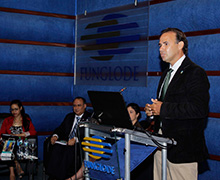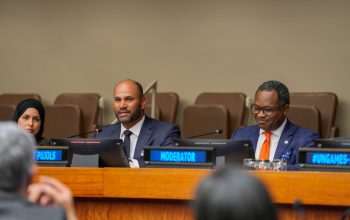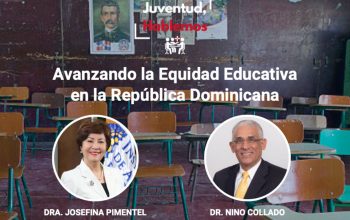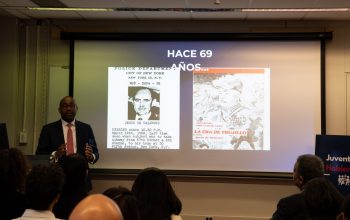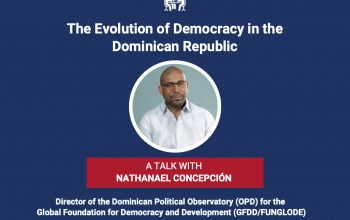news
“Rise of Algae in Coral Reefs is the Result of Pollution and Lack of Herbivorous Fish” States Rubén Torres, President of Reef Check DR During GFDD/Funglode Publication Launch
October 8, 2015
(Santo Domingo, October 9, 2015) –The problem confronting coral reefs in the Dominican Republic and the Caribbean is due to “a lack of herbivorous fish and pollution,” said Rubén Torres, president and Executive Director of Reef Check Dominican Republic, during a panel discussion at the launch of “Climate Change in the Dominican Republic: Impact on Coastal Resources and Communities.”
“The
abundance of algae, which are the main cause of death of Caribbean coral, reduces the ability of new coral to reach these waters, settle and grow. It also inhibits growth by 80% among the coral that does become established.” The marine biologist referred to the results of a data analysis completed by Jeremy Jackson in 2014, considering the health of coral reefs over the last four decades. It should be noted that the algae mentioned in the study are not the same as the algae that
is currently invading the Caribbean coasts, which are floating algae known as Sargassum.
“Caribbean reefs are deforested forests; there are no large animals remaining and the seabed is overrun with weeds, which in our case would be algae.” He added that increased water pollution causes the reproduction of algae, because it is food for them. “Following the death of black sea urchins, algae increased between 300 or 500 percent,”
according to the report.
The book, “Climate Change in the Dominican Republic: Impact on Coastal Resources and Communities” authored by Hilary Lohmann and Mat Rosa, was presented on Wednesday, October 7th as part of a panel discussion organized by the Fundación Global Democracia y Desarrollo (Funglode) and its sister institution in the United States, the Global Foundation for Democracy and Development (GFDD). Both authors were researchers and
participants of the 2014 GFDD Fellows Program.
Other participants, in addition to Dr. Torres, who took part in the panel included Hilary Lohmann; Elizabeth McLean, research associate at the Center for Coastal Resources of the University of Rhode Island (URI); Ana Carolina Beras, environmental specialist of the United Nations Development Programme (UNDP) in the Dominican Republic and Omar Ramirez, director of the Center for the Study of the Environment and Sustainable
Development of Funglode.
Dr. Torres explained that with sea levels rising as a result of climate change, the majority of tourist areas around the country could disappear. He stressed the importance to consider that “as a very vulnerable nation” the Dominican Republic should ”promote tourism in the mountains.”
Fellows Program researcher, Hilary Lohmann, presented the findings of the new study, which was conducted
along the coastal areas of Montecristi, Samaná, Boca Chica and La Caleta, by surveying direct and indirect users of resources that come from the sea.
Ms. Lohmann explained that “the capacity for adaptation helps determine the vulnerability or resilience (how inhabitants adjust to changes in their environment without altering its structure and functionality) of a community in the face of climate change.”
“Communities are
often integrated systems comprised of individuals who depend on natural resources,” she said, adding that peoples’ dependence on these natural resources stem from various reasons, such as “nutrition, livelihood or security.”
Elizabeth McLean, research associate at URI’s Center for Coastal Resources, talked about “adaptation to climate change and coastal resistance.” She affirmed that “islands
will be more affected by climate change and this will in turn impact their economic and social development.”
In that the damage this phenomenon could cause in the future is unknown, it is necessary to take action that will protect people and economic resources. Ms. McLean suggested, “creating taller infrastructures, using renewable energy and changing how we build along the coasts.”
“People with just one
occupation are the most vulnerable to adaptation,” said the researcher. She added that, “reducing the impact of climate change has its costs and limitations, therefore requires cooperative actions.”
In her speech, Ana Carolina Beras, UNDP environmental specialist in the country, talked about the projects being undertaken by the organization. She said the Dominican Republic is among the 10 countries most vulnerable to climate change.
“The UNDP is developing a sustainable tourism project called Conserving Biodiversity in Coastal Areas Threatened by Rapid Tourism and Physical Infrastructure Development,” said Ms. Beras.
The specialist pointed out that “dependence on the tourism sector has made the Dominican economy especially vulnerable,” and that, due to climate change, “summers are hotter, water is scarce, sea levels are rising and there are
larger numbers of illnesses.”
Omar Ramírez, vice president of the Consejo Nacional para el Cambio Climático, said the most pressing environmental challenge facing the country is the need to conserve its coral reefs.
He also noted that climatic processes that are underway on a global level “are destroying the economies of many nations.”
“It is necessary to take stock of the country’s
losses with regard to these atmospheric phenomena and urge the government to get up to speed and deal with them,” added Ramírez, who is also director of the Centro de Estudios de Medio Ambiente y Desarrollo Sostenible of Funglode. He said, “society should be aware and should demand an increase in the Ministry of the Environment’s budget, so that it can better tackle this phenomenon.”
Yamile Eusebio, GFDD Office Director in New York
who gave the welcoming speech, reminded the audience that the book provides “the country’s coastal communities with new perspectives and innovative strategies to find solutions and adapt to the economic, social and environmental problems posed by climate change.”

